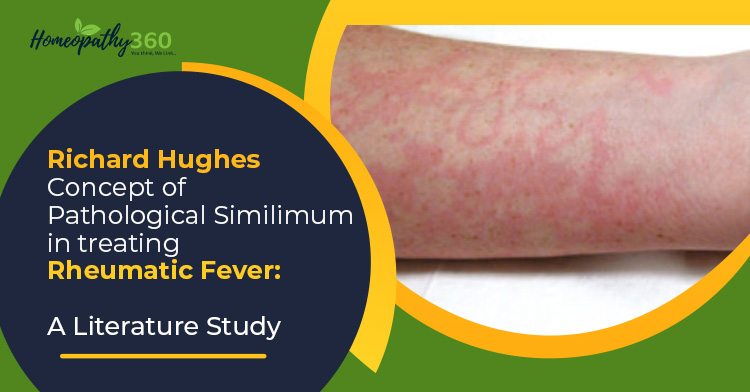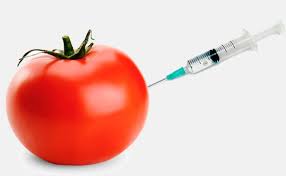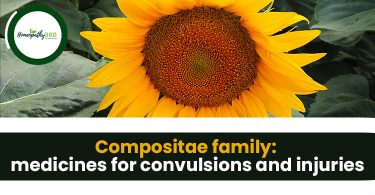
Richard Hughes concept of pathological similimum in treating rheumatic fever : A Literature study
ABSTRACT
Rheumatic fever is a nonsuppurative complication of pharyngeal infection with group A Streptococcus (GAS). Signs and symptoms develop two to three weeks following pharyngitis and include arthritis, carditis, chorea, subcutaneous nodules, and erythema marginatum.
INTRODUCTION1
Rheumatic fever is an immunological disorder that follows infection of pharynx by a group A beta-haemolytic streptococci. It affects the heart, joints, CNS, skin and subcutaneous tissue. It’s a non-infectious, non-suppurative sequele of streptococcal.
EPIDEMOLOGY
Age Group: 5 – 15years
Both genders are equally affected. Mitral valve disease and chorea are common in females and aortic valve involvement is common in males.
Prevalance: 0.6/1000
AETIOLOGY
Group A B- haemolytic streptococcus : Pathogenic strains are M type 1,3,5,6,18,19,24 . Type 18 is the most virulent mucoid strain.
Genetic Influence : The presence of specific allo antigen on the surface of non-T lymphocytes in 70% – 90% of rheumatic fever patients favours genetic predisposition
Auto immunity
RISK FACTORS
Upper Respiratory tract infection
Poor Socio-economic class
Seasonal Variation
Climate : Temperate Subtropical and tropical
Hereditary Predisposition
Previous attack carries a risk of 50% recurrence.
CLINICAL FEATURES
“Bites the heart,licks the joint and kicks the brain”
Symptoms occur around 1-5 weeks after an initial attack of pharyngitis.
Fever,Anorexia,lethargy and joint pains may be present
Family History of rheumatic fever is often positive.
DIAGNOSTIC CRITERIA
1st Rheumatic fever outbreak
2 major criteria
1 major + 2 minor
Rheumatic fever relapse
2 major criteria or
1 major + 2 minor or
3 minor
INVESTIGATIONS
Blood routine – Elevation of ESR >60mm in 1st hour
CRP >3mg/dL
ECG – Prolonged PR interval, corrected for age
COMPLICATIONS
Rheumatic heart disease is permanent damage to the heart caused by rheumatic fever. It usually occurs 10 to 20 years after the original illness. Problems are most common with the valve between the two left chambers of the heart (mitral valve), but the other valves can be affected. The damage can result in:
Valve stenosis
Valve regurgitation.
Damage to heart muscle
Damage to the mitral valve, other heart valves or other heart tissues can cause problems with the heart later in life. Resulting conditions can include:
Atrial fibrillation
Heart failure
HOMEOPATHIC THERAPEUTICS 2,3,4
Well selected Homoeopathic medicines are effective for the management of Rheumatic fever. Some important remedies are given below-
ACONITUM NAPELLS – There redness of the shining swelling of the affected part with shooting and tearing pain, worse at night and by touch. The throat is dry, red, constricted, numb, pricking, burning and stinging. Tonsils swollen and dry.
ANACARDIUM ORIENTALE – is effective for Rheumatic fever with affections of pericardium. There is rheumatic pericarditis with double stitches. Stitching pain in the heart region which may passing in to the lumbar region. Palpitation and uneasiness in the heart.
ARNICA MONTANA – There is soreness, numbness and swelling of the affected joint. Intercostal rheumatism simulates pleurisy. There is stitching pain in the heart region. Heart complaints with dilatation and dysponea. Weakened heart muscles.
AURUM METALLICUM – There is valvular lesions of heart. Heart feels loose on walking. Sensation as if heart stopped beating for two or three seconds, immediately followed by tumultuous rebound with sinking at the epigastrium. Violent palpitation compels him stop.
CACATUS GRANDIFLORUS—It is excellent for inflammatory rheumatism with heart complaints. The main symptom is a feeling of constriction everywhere. There is constriction of heart, as if an iron band prevented its normal movement or as if caged. Rheumatic pains in shoulders, upper and lower arms, in hips, down to feet, worse in rest and in motion and in all positions.
DROSERA ROTUNDIFOLIA –Drosera is suited to tubercular constitutions. Fever with internal chilliness, shivering, with hot face and cold hands. There is no thirst. The bed feels too hard. Shivering when rest, on moving no shivering. Febrile rigor all over the body. There is gnawing and shooting pain in the shafts of the long bones, arms, thighs, and legs. Severe stitching pain in joints, especially ankle joint. Pain as if dislocated and with great stiffness.
EUPATORIUM PERFORATUM – Eupatorium suited to worn out constitutions from inebriety. There is high temperature and chills. Chill preceded by thirst with great soreness and aching of bones. There is much shivering. The patient feels that the bones bruised, broken and dislocated. Rheumatism with perspiration nad soreness of bones.Joints mainly affected are hip, shoulder, inside knee, foot, great toe, and elbow. There is sharp pain in hip, ankle and shoulder joints, worse from 10 a.m .to 4 p.m. The patient wants to keep still, but must move.There is pressure in heart region as if the heart is too small a space.There is pain, soreness and heaviness behind sternum and cardiac region worse by least motion and turning the body around.
FERRUM PHOS –There is high fever with acute articular rheumatism. Rheumatism affecting one joint after another, joints puffy but little red. Red, swollen and very sensitive joints, worse from least movement. Throat sore and ulcerated. Tonsils red and swollen.
GELSEMIUM is suited to persons of a nervous and hysterical temperament. Fever with great prostration and headache. Fever with chills up and down the back. Heat and sweat stage long lasting. There is no thirst. The patient wants to be held because he shakes so. There is a feeling as if it were necessary to keep in motion or else hearts action would cease. Pulse, slow, full, soft, and compressible.
KALMIA LATIFOLIA is best for Rheumatic fever with migratory rheumatism with heart complaints. Kalmia is best for protracted and continues fevers with tympanites. Here the rheumatic pain extends downwards and shift suddenly. Pain affect a large part of the limb or several joints and pass through quickly. Joints red, hot and swollen. There is tingling and numbness of left arm with heart complaints. There is sharp pain in the heart region which is burning, shooting, or stabbing radiating to the left arm. Violent palpitation is another leading symptom, which is worse learning forward.
RHUS TOXICODENDRON – There is soreness and stiffness of joints. Pain in chest, worse by using arms in making a bed..The affected joints are red, swell, having much shining with rigidity or shooting when touched. Heart feels tired, pains go down left arm. There is trembling and palpitation when sitting still.
SALICYLIC ACID – Salicylic acid is best for Rheumatic fever with inflammatory rheumatism of one or more joints, especially elbows or knees along with fever. There is high fever with swelling and redness of joints. Movements very difficult and sensitive to least jar.
SPIGELIA -. Sore throat with lancinations and swelling in palate.There is drawing , tearing twitching pain in limbs and joints. Rheumatic carditis with trembling pulse. There is violent palpitation which is audible.
CONCLUSION
Every person has his own individuality & this individuality is not just at the level of health but also at the level of disease as well. There are many approaches in our system of medicine but as our master Dr Hahnemann stated in his first 5 aphorisms, our mission is to treat an individual & only a homoeopath with true knowledge of system will be able to give justice his patients. The knowledge here also means the right approach to the cases, its physicians call to decide which approach he has to go with, and when we are unable to find the true picture of the disease its always better to analyse the pathological background of the case & treat accordingly, amongst all the methods available, the concept of Pathological similimum will be a right choice of treatment strategy when there are more of pathological symptoms, hence in this article we will be able to select few of the top homoeopathic remedies based on pathology for the treatment of rheumatic fever.
BIBLIOGRAPHY
1.Lakshmanaswamy, A., 2022. Clinical Paediatrics. 5th ed. Ghaziabad: Wolters Kluwer, pp.319-328.
2. Choudhuri, N., 2006. A Study on materia medica. New delhi: B Jain , Publishers.
3. Boericke, W., 2015. Pocket Manuel of Homeopathic manual and Repertory. 37th ed. New delhi: B Jain.
4. Linkedin.com. 2022. HOMOEOPATHY FOR RHEUMATIC FEVER. [online] Available at: <https://www.linkedin.com/pulse/homoeopathy-rheumatic-fever-dr-ks-gopi> [Accessed 24 June 2022].
About Author:
Dr Omkar Sreekumar
PG Scholar
Dept. of Paediatrics
Fr Muller Homeopathic Medical College
Mangalore , Karnataka





